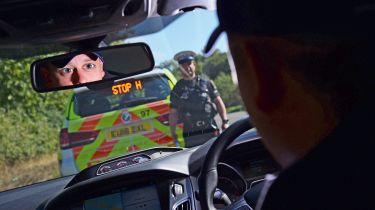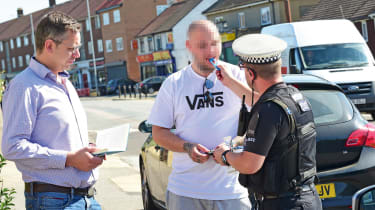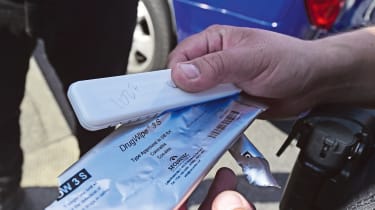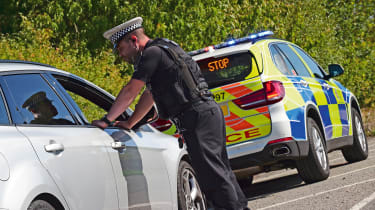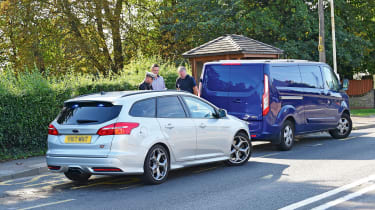How police tackle drug-drivers on the road: tests, penalties and powers
We join Essex Police on patrol as officers crack down on motorists who have taken cocaine or cannabis using DrugWipe tests
Drink-drivers killed more than 1,600 people in 1979. Fast-forward to the latest official figures, and 230 people died at the hands of drink-drivers in 2016. That’s still 230 too many, but it shows how dramatic an improvement in road safety a shift in public perception can bring.
Authorities are now turning their attention to drug- driving. Police previously had to prove a motorist’s driving was affected by drugs, but a change to the law in 2015 means officers now need only prove the presence of drugs in someone’s system to arrest them.
• UK drug-driving limits explained
Along with updated laws, an important tool in the fight against intoxicated driving is the DrugWipe roadside drug test. Capable of detecting cannabis and cocaine in a suspect’s saliva, DrugWipe means officers can check if a driver has taken illegal drugs almost as easily as they can excess alcohol. But while laws and detection systems surrounding drug-driving have become more stringent, officers are concerned that the message isn’t getting through.
Police in Essex, for example, arrested 754 drug-drivers in 2017 (up from 705 in 2016), and look set to arrest more than 900 drivers for the offence before 2018 is out. Nationwide, 25,000 drug-drivers were caught between March 2015 and January 2018.
We’re joining Essex Police’s road traffic division for a shift, to find out what sort of challenges officers face, and what public reaction to the updated laws has been.
Police powers and testing drivers for drugs
Traffic officer Mark Hewitt gives us a briefing before we head off. “We’ve always had the power to investigate drug-driving, but ‘touch your nose’ field impairment tests are very subjective”, PC Hewitt says.
The arrival of the DrugWipe test, which looks very much like a home pregnancy test, has removed that subjectivity. Drivers who provide a positive saliva sample at the roadside are arrested and taken to a police station for a blood test, which forms the evidential basis for prosecution.
“The legislation is quite good from our perspective,” Hewitt says. “Anyone who has committed a moving road traffic offence gives us the power to require a sample of saliva from them, no different from a drink-drive test.” Refusal to provide a saliva sample is an arrestable offence in itself and, unlike alcohol, which disappears relatively quickly from people’s bodies, drugs, and cannabis in particular, can be detected days after they have been taken.
PC Hewitt says drivers are often unaware of this. “I’ve heard people say they smoked two days ago, and the test has come back positive.” He admits, however, that the people he encounters might not always be telling the truth on that one.
We finish our coffee, wrap up the chat and head out on patrol to Hewitt’s unmarked Ford Focus ST estate. We’re on the lookout for people who are driving in a manner consistent with drug use, and it doesn’t take long to find our first suspect.
A Ford Transit overtakes a car on a roundabout exit. It’s an eye-catching manoeuvre, not least for the van’s bright blue colour. Hewitt can’t ignore it, and puts on his blues and twos. We pull up the van in a layby, and its driver immediately concedes he was driving too fast. “I’ve just spent an age stuck behind four tractors,” he explains. “I put my foot down, and shouldn’t have.”
• What are the drink drive laws?
The driver agrees to a DrugWipe test, so Hewitt removes the cap, wipes the end of it on the suspect’s tongue, replaces the cap then squashes a small vial housed in the end of the kit. This releases the chemical that detects cannabis and cocaine. A red control line indicates the reactant chemicals have been released, and we wait to see if a second line appears next to either the cannabis or cocaine. If this appears, the driver will be arrested.
The test comes back clean, and the driver says he was unaware police have the ability to detect drugs at the roadside. “I think it’s a good thing,” he tells us, going so far as to ask for a selfie with Hewitt. “I’m going to think about getting some tests for my employees. A lot of them are young.”
We head back out on patrol, looking for more poor examples of driving, and do a double-take at what we see next. A green Renault Scenic drives past with what looks like a length of coving sticking some way out of its boot. As we spin around and get closer, it soon becomes clear the load is also sticking out of the front passenger window by several feet.
We stay in the car as Hewitt deals with the driver and their abnormal load (which turns out to be a piece of conservatory), and he comes back saying his instincts told him the driver wasn’t high. With each DrugWipe test costing £18, it’s understandable he deals with the offence in hand rather than testing for drugs indiscriminately. And officers’ instincts tend to be accurate, with roughly 60 to 70 per cent of the roadside tests issued by Essex Police generating a positive result for cannabis or cocaine.
Next, a van driver gets a straight six-point, £200 penalty for using his phone behind the wheel, then we spot a Corsa driver not wearing his seatbelt, and the familiar lights and sirens go on. The driver steps out of his car, and Hewitt explains that he’s going to be tested for drugs. The motorist agrees without complaint and, once the test comes back negative, is dealt with at the roadside for the seatbelt offence.
We’re hardly on the road for 10 minutes when we see another driver with no seatbelt. This is the second green Renault Scenic we’ve pulled over, and Hewitt again judges its middle-aged female driver is unlikely to be high on weed or coke. Nonetheless, a quick check of her records reveals no insurance, and her “previous offending history” means her car is seized, so she’s sent on her way, carless, with the appropriate penalty.
Hewitt is singled-manned for this shift, so we have to wait for around 45 minutes for a recovery truck to pick up the Scenic, before making our way back to base.
While waiting by the roadside was frustrating, the varied and vital nature of police work becomes clear as we head back to the station. Great plumes of smoke fill several roads ahead, with one street rendered completely invisible by the thick fog. Hewitt gets on the radio: “Guys, is anyone attending or aware of the massive fire in the middle of town?”
The answer comes back negative, and Hewitt asks us to get out of the car, as he assumes the role of first officer on the scene. After liaising with firefighters and helping to cordon off the area, it becomes clear that a major fire has taken hold of a three-storey block of flats.
Our day may not have ended with any arrests for drug-driving, but it’s clear Essex officers are well attuned to look for its effects. We asked Hewitt if he had a message for potential drug-drivers. “Don’t drive,” he says. “It’s the same as drink-driving. It’s as simple as that.”
For more great automotive features, take a look at our dedicated features page...
Find a car with the experts

